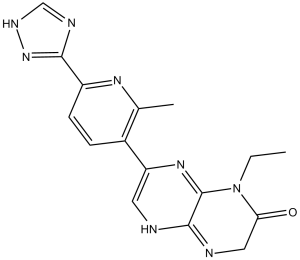CC-115 (CC115) is a novel and potent dual inhibitor of DNA-PK (DNA-dependent protein kinase) and mTOR (mammalian target of rapamycin) with IC50s of 13 nM and 21 nM, respectively and with potential antineoplastic activity. It was reported that CC-115 could reverse CD40-mediated resistance to venetoclax and fludarabine as well as totally block the proliferation brought on by CD40(+) interleukin-21 stimulation. Furthermore, CC-115 and CLL samples from patients who developed resistance to idelalisib treatment inhibited BCR-mediated signaling.
Physicochemical Properties
| Molecular Formula | C16H16N8O | |
| Molecular Weight | 336.35 | |
| Exact Mass | 336.145 | |
| Elemental Analysis | C, 57.13; H, 4.79; N, 33.31; O, 4.76 | |
| CAS # | 1228013-15-7 | |
| Related CAS # |
|
|
| PubChem CID | 58298318 | |
| Appearance | Red Solid powder | |
| LogP | 1.613 | |
| Hydrogen Bond Donor Count | 2 | |
| Hydrogen Bond Acceptor Count | 7 | |
| Rotatable Bond Count | 3 | |
| Heavy Atom Count | 25 | |
| Complexity | 491 | |
| Defined Atom Stereocenter Count | 0 | |
| SMILES | O=C1C([H])([H])N([H])C2C(=NC(=C([H])N=2)C2C([H])=C([H])C(C3=NC([H])=NN3[H])=NC=2C([H])([H])[H])N1C([H])([H])C([H])([H])[H] |
|
| InChi Key | GMYLVKUGJMYTFB-UHFFFAOYSA-N | |
| InChi Code | InChI=1S/C16H16N8O/c1-3-24-13(25)7-18-15-16(24)22-12(6-17-15)10-4-5-11(21-9(10)2)14-19-8-20-23-14/h4-6,8H,3,7H2,1-2H3,(H,17,18)(H,19,20,23) | |
| Chemical Name | 5-ethyl-3-[2-methyl-6-(1H-1,2,4-triazol-5-yl)pyridin-3-yl]-7,8-dihydropyrazino[2,3-b]pyrazin-6-one | |
| Synonyms |
|
|
| HS Tariff Code | 2934.99.9001 | |
| Storage |
Powder-20°C 3 years 4°C 2 years In solvent -80°C 6 months -20°C 1 month |
|
| Shipping Condition | Room temperature (This product is stable at ambient temperature for a few days during ordinary shipping and time spent in Customs) |
Biological Activity
| Targets | DNA-PK ( IC50 = 13 nM ); mTOR ( IC50 = 21 nM ); PI3Kα ( IC50 = 852 nM ); mTORC1; mTORC2 | |
| ln Vitro |
|
|
| ln Vivo |
|
|
| Enzyme Assay | For mTOR kinase, an HTR-FRET substrate phosphorylation assay is used. The mobility shift assay format is used to outsource PI3Kα IC50 determinations. Compounds (like CC-115) are evaluated in relation to ATP concentrations at roughly the assay Km, with average ATP Kms for the mTOR and PI3K assays being 15 μM and 50 μM, respectively[1]. | |
| Cell Assay | In growth media, PC-3 cells are cultivated. MesoScale technology is used to assay pS6 and pAkt levels in cells after a one-hour treatment for biomarker studies. Cells treated with a compound (CC-115, for example) are left to grow for 72 hours in order to conduct proliferation experiments. The percentage of the DMSO-treated cells is shown for each normalized set of data. The IC50 values of the results are then presented[1]. | |
| Animal Protocol |
|
|
| References |
[1]. Optimization of a Series of Triazole Containing Mammalian Target of Rapamycin (mTOR) Kinase Inhibitors and the Discovery of CC-115. J Med Chem. 2015 Jul 23;58(14):5599-5608. |
|
| Additional Infomation |
CC-115 has been used in trials studying the treatment of Prostate Cancer, Neoplasm Metastasis, Ewing's Osteosarcoma, Glioblastoma Multiforme, and Chronic Lymphocytic Leukemia, among others. DNA-PK/TOR Kinase Inhibitor CC-115 is a dual inhibitor of DNA-dependent protein kinase (DNA-PK) and mammalian target of rapamycin (mTOR), with potential antineoplastic activity. CC-115 binds to and inhibits the activity of DNA-PK and both raptor-mTOR (TOR complex 1 or TORC1) and rictor-mTOR (TOR complex 2 or TORC2), which may lead to a reduction in cellular proliferation of cancer cells expressing DNA-PK and TOR. DNA-PK, a serine/threonine kinase and a member of the PI3K-related kinase subfamily of protein kinases, is activated upon DNA damage and plays a key role in repairing double-stranded DNA breaks via the DNA nonhomologous end joining (NHEJ) pathway; mTOR, a serine/threonine kinase that is upregulated in a variety of tumors, plays an important role downstream in the PI3K/Akt/mTOR signaling pathway. |
Solubility Data
| Solubility (In Vitro) |
|
|||
| Solubility (In Vivo) |
Solubility in Formulation 1: ≥ 2 mg/mL (5.95 mM) (saturation unknown) in 10% DMSO + 40% PEG300 + 5% Tween80 + 45% Saline (add these co-solvents sequentially from left to right, and one by one), clear solution. For example, if 1 mL of working solution is to be prepared, you can add 100 μL of 20.0 mg/mL clear DMSO stock solution to 400 μL PEG300 and mix evenly; then add 50 μL Tween-80 to the above solution and mix evenly; then add 450 μL normal saline to adjust the volume to 1 mL. Preparation of saline: Dissolve 0.9 g of sodium chloride in 100 mL ddH₂ O to obtain a clear solution. Solubility in Formulation 2: ≥ 2 mg/mL (5.95 mM) (saturation unknown) in 10% DMSO + 90% (20% SBE-β-CD in Saline) (add these co-solvents sequentially from left to right, and one by one), clear solution. For example, if 1 mL of working solution is to be prepared, you can add 100 μL of 20.0 mg/mL clear DMSO stock solution to 900 μL of 20% SBE-β-CD physiological saline solution and mix evenly. Preparation of 20% SBE-β-CD in Saline (4°C,1 week): Dissolve 2 g SBE-β-CD in 10 mL saline to obtain a clear solution. (Please use freshly prepared in vivo formulations for optimal results.) |
| Preparing Stock Solutions | 1 mg | 5 mg | 10 mg | |
| 1 mM | 2.9731 mL | 14.8655 mL | 29.7309 mL | |
| 5 mM | 0.5946 mL | 2.9731 mL | 5.9462 mL | |
| 10 mM | 0.2973 mL | 1.4865 mL | 2.9731 mL |
